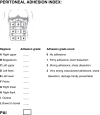Peritoneal adhesion index (PAI): proposal of a score for the "ignored iceberg" of medicine and surgery
- PMID: 23369320
- PMCID: PMC3573980
- DOI: 10.1186/1749-7922-8-6
Peritoneal adhesion index (PAI): proposal of a score for the "ignored iceberg" of medicine and surgery
Abstract
Peritoneal adhesions describe a condition in which pathological bonds form between the omentum, the small and large bowels, the abdominal wall, and other intra-abdominal organs. Different classification systems have been proposed, but they do not resolve the underlying problem of ambiguity in the quantification and definition of adhesions. We therefore propose a standardized classification system of adhesions to universalize their definition based on the macroscopic appearance of adhesions and their diffusion to different regions of the abdomen. By scoring with these criteria, the peritoneal adhesion index (PAI) can range from 0 to 30, unambiguously specifying precise adhesion scenarios. The standardized classification and quantification of adhesions would enable different studies to more meaningfully integrate their results, thereby facilitating a more comprehensive approach to the treatment and management of this pathology.
Figures
References
-
- Ellis H. The clinical significance of adhesions: focus on intestinal obstruction. Eur J Surg Suppl. 1997;577:5–9. - PubMed
-
- Pouly JL, Seak-San S. In: Peritoneal surgery. DiZerega GS, editor. Springer, New York; 2000. Adhesions: laparoscopy versus laparotomy; pp. 183–192.
LinkOut - more resources
Full Text Sources
Other Literature Sources


